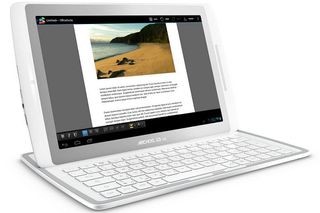IT Pro Verdict
The budget tablet market is hotting up thanks to Google’s Nexus 7, and Archos has done well to offer something different with the 101 XS. In practice, though, the Coverboard and its keyboard don’t work particularly well – its quirks and shortcomings mean you won’t be getting up to speed any time soon. That makes it difficult to recommend as a device for any serious work but, as a budget 10.1in Android tablet, there’s a lot to like about the Archos.
In a tablet market dominated by Apple, Archos is trying to tempt users with a hybrid Android device at a low price. We take a look to see if the 101 XS business users the functionality of premium tablets or is just another pretender.
The Coverboard
The most noticeable feature of the 101 XS is the Coverboard, which is attached to the main tablet. A grey strip around its border magnetically attaches it to the main body of the tablet and, at the back, a stand folds up from its 5mm body. Occupying two-thirds of the Coverboard is its keyboard, which links to the tablet with a small electronic connection and is held in place by a pair of strong magnets and a plastic stand that flips up from the base.

The keyboard is attached, but isn't the best if you plan to use it for long periods
The QWERTY keyboard feature a number of Android-specific keys. The Escape key is replaced by the back button, there's a Home key beside the CTRL key, and the Windows button that's found on PC keyboards has been replaced by one that opens up Android's carousel of recently-used applications. There's also buttons to open menus within apps, the search box and the settings menu.
It's a different approach to other tablets which have arrived with laptop-style bases, such as the Asus Transformer Pad Infinity 700, and has its advantages and disadvantages. The main plus points are the size and weight: with the Coverboard clipped to the tablet, the entire device is 13mm thick and tips the scales at 800g. The Asus, meanwhile, is 19mm thick and weighs 1.1kg the sort of dimensions we'd expect from smaller Ultrabooks.
The downside, however, comes when the keyboard is actually used whereas the Asus delivered a laptop-style experience, the cheaper Archos doesn't come close. The keys are too small, the slimline Coverboard affords the keys very little travel, and unless they're hit with reasonable force they occasionally fail to register at all.
Mike Jennings has worked as a technology journalist for more than a decade and has been fascinated by computers since childhood, when he spent far too long building terrible websites. He loves desktop PCs, components, laptops and anything to do with the latest hardware.
Mike worked as a staff writer at PC Pro magazine in London for seven years, and during that time wrote for a variety of other tech titles, including Custom PC, Micro Mart and Computer Shopper. Since 2013, he’s been a freelance tech writer, and writes regularly for titles like Wired, TechRadar, Stuff, TechSpot, IT Pro, TrustedReviews and TechAdvisor. He still loves tech and covers everything from the latest business hardware and software to high-end gaming gear, and you’ll find him on plenty of sites writing reviews, features and guides on a vast range of topics.
You can email Mike at mike@mike-jennings.net, or find him on Twitter at @mikejjennings

